Illegal street drugs and prescription drug misuse can be tracked via emergency room visits. But what about “legal highs,” such as inhalants like glue and paint?
MXE Abuse
A study by Swedish researchers provides insight into the use of Methoxetamine, or MXE. The drug is classed as a “research chemical” and can be purchased online. The study was published in the Journal of Psychoactive Drugs.
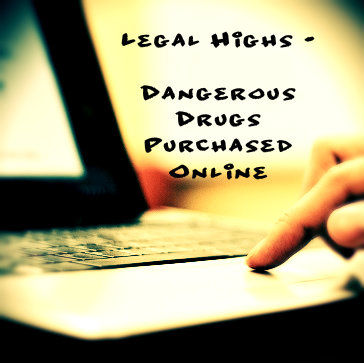 MXE is made from ketamine, a drug popularly used at clubs for its hallucinogenic and dissociative effects. Ketamine is also used for ketamine psychedelic psychotherapy, a tool used to treat depression and dependence disorders. MXE is similar in many ways to ketamine when used, but MXE tends to last longer and provide a more potent experience. The use of such substances can create a challenge for clinicians because they have little information about the contents of the drug, the interactions or side effects that are likely to occur with use.
MXE is made from ketamine, a drug popularly used at clubs for its hallucinogenic and dissociative effects. Ketamine is also used for ketamine psychedelic psychotherapy, a tool used to treat depression and dependence disorders. MXE is similar in many ways to ketamine when used, but MXE tends to last longer and provide a more potent experience. The use of such substances can create a challenge for clinicians because they have little information about the contents of the drug, the interactions or side effects that are likely to occur with use.
The researchers used online public forums to examine postings about the use of MXE. This type of study, called a phenomenological review, is useful in collecting information about experiences and perceptions. The researchers were able to gather data from anonymous posters on the sites.
MXE Effects
MXE users described dissociative properties similar to those associated with ketamine and altered states of consciousness. MXE was also reported as creating an elevated mood, an experience of euphoria, as well as long-lasting antidepressant effects, interests in new activities and personal growth.
The study’s design carries with it significant limitations. The use of anonymous reports to create a picture of the drug’s effects and risks is not the ideal way to measure the properties of a drug. However, the study provides important insight that could lead to more in-depth research. Next steps would include more systematic methods of research, including reliable measurements of effects, side effects and predictors for use.
Social Media’s Role In Mental Health Research And Drug Abuse Awareness
Social media is growing as a resource for mental health research. The use of public forums on drug use, combined with postings on other Internet sources, may not provide the same robust information as other types of study designs, but they may result in findings that provide a candid and unedited picture of users’ experiences.
The research may be helpful in raising awareness about the dangers of using chemicals to achieve a high similar to street drugs. Because they are legal and for sale on the Internet, users may misunderstand the level of danger attached to the use of these drugs. In addition to using the Internet to gather information about the use of MXE, social media may also be useful and play a role in raising awareness about the negative consequences of MXE use.
18 Nov 2013
E-Cigarettes Secretly Used To Hide Drug Use
The e-cigarette is a modern invention and an alternative to tobacco cigarettes. They were designed to allow people to smoke and to get nicotine into the bloodstream without inhaling all of the toxins found in tobacco. E-cigarettes may be helping people to quit smoking, and because they do not produce actual smoke, they may also allow people to get their nicotine without affecting the people around them.
On the surface, it seems that e-cigarettes are a great invention that can help people. Unfortunately, there are downsides to these fake cigarettes, not least of which is the fact that they can be used to smoke illegal drugs, like marijuana. Because of the way they work, someone can smoke pot using an e-cigarette without being detected.
The E-Cigarette Revolution
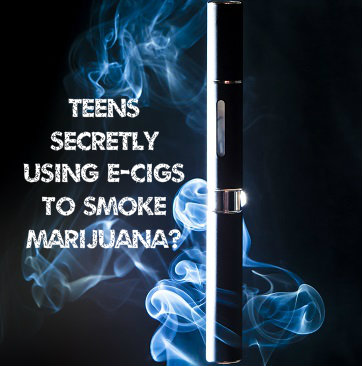 An e-cigarette is different from a traditional cigarette in that it does not use tobacco. Instead, it uses batteries and a liquid solution of nicotine. The battery heats and vaporizes the solution so that the user inhales and exhales vapors, rather than smoke. Because nicotine is the only ingredient, the user is also not inhaling all of the additives in tobacco that are so harmful, such as tar, acetone and arsenic.
An e-cigarette is different from a traditional cigarette in that it does not use tobacco. Instead, it uses batteries and a liquid solution of nicotine. The battery heats and vaporizes the solution so that the user inhales and exhales vapors, rather than smoke. Because nicotine is the only ingredient, the user is also not inhaling all of the additives in tobacco that are so harmful, such as tar, acetone and arsenic.
Although nicotine is still a drug, and one that is harmful and addictive, smoking an e-cigarette is much less dangerous than smoking tobacco cigarettes. It is also less harmful to others around the smoker because there is no secondhand smoke. Without the offensive fumes, it may be possible for people to smoke using e-cigarettes in areas that are normally restricted to smokers.
For the above reasons, e-cigarettes are set to become big sellers in the U.S. and elsewhere. Some experts are even predicting that they will start to outsell real cigarettes within a decade. E-cigarettes are already big business in Europe. The European Parliament recently rejected a proposal to regulate them as medical devices, which would have meant tight restrictions on sales.
E-Cigarettes Being Used To Smoke Marijuana
Although e-cigarettes may have been created as healthier, alternative delivery devices for nicotine and to help smokers kick the habit, clever drug users have already crafted them for different uses. The cartridge of liquid nicotine solution that goes into an e-cigarette can easily be replaced by any liquid. Any substance can be vaporized and inhaled using one of these devices.
Most commonly, abusers are using a cartridge with a liquid solution of THC, the main psychoactive substance found in marijuana. With liquid THC in an e-cigarette, a person can get high and yet appear to be legally inhaling legal, nicotine vapors. The same property of e-cigarettes that allows users to smoke without offending those around them, allows for covert use of illicit drugs. The vapors produced by the e-cigarette are odorless. A person can get high without arousing suspicions.
Teens Smoking Marijuana With No Recognizable Odor
While an adult covertly smoking pot is a concern, a bigger one is the use of marijuana by teenagers. As the presence of e-cigarettes proliferates, teens are finding that they make an excellent vehicle for smoking pot. Smoking marijuana produces a characteristic odor that clings to clothes, hair and fingers. With e-cigarettes, a teen can inhale liquid THC, get high, and never give off the usual signs. Parents who are concerned that their teens may be using marijuana will have to be more vigilant and look for other signs of intoxication.
E-Cigarettes Targeting Young People?
Another concern regarding teens and e-cigarettes is that these new devices may be targeting young people. E-cigarettes can be sold with different types of nicotine cartridges with flavors like strawberry, peach and grape. They are also sold online, which makes it easier for kids to get a hold of them. If kids start using these devices at a young age, they may be more inclined to try other substances. In other words, e-cigarettes may become the new gateway drug. The problem has already begun, as statistics indicate that the number of middle and high school students using e-cigarettes is rising.
It seems that e-cigarettes have a place in our modern world. They allow adults to use a legal substance in a way that is less harmful than cigarettes. They also help those who want to quit the habit of smoking. On the other hand, e-cigarettes pose a big problem. Until we can figure out how regulate them fairly, or how to detect illegal drugs being used in e-cigarettes, parents and other adults should be aware of the possibility that they are being abused by teens.
Read About Smoking Marijuana And The Future Effects On Teens
11 Nov 2013
Meth Addiction And The Effects In Teens
Fans of the hit crime drama Breaking Bad may have become familiar with the dangers of methamphetamine use. However, as a parent, you may have questions about methamphetamine abuse in teenagers and whether it requires drug rehab treatment. Surveys suggest that 2 to 3.5% of adolescents have used methamphetamines [1]. Also called “speed” or “glass”, it’s a highly addictive stimulant.
How Meth Works
Methamphetamine – or “meth” for short – is a type of amphetamine, a drug that acts on the body’s central nervous system. The drug works by increasing dopamine levels within the brain to very high levels. Dopamine is the brain chemical that’s linked to pleasure, reward, motivation, and also motor function. When dopamine levels skyrocket, as they do during meth use, the user experiences a pleasurable rush that is often compared to euphoria.
While there are several types of amphetamines, meth is generally considered the most potent. The drug can be snorted, injected, or taken orally. Some abusers use a method called parachuting, which involves crushing a pill and then rolling the powder into a piece of tissue or toilet paper. The entire package – tissue and all – is then swallowed, delivering what’s believed to be a stronger, faster high because the pill’s outer protective layer has been destroyed.
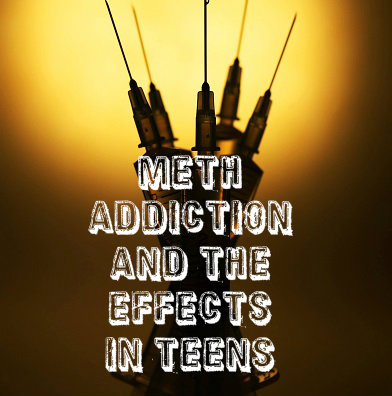 Teen meth addicts will typically use daily or nearly daily. Addiction requiring drug rehab treatment can develop quickly, sometimes within just a few uses. Chronic abuse of the drug leads to tolerance. As one’s tolerance level increases so does the amount of the drug that’s needed in order to achieve the euphoric high.
Teen meth addicts will typically use daily or nearly daily. Addiction requiring drug rehab treatment can develop quickly, sometimes within just a few uses. Chronic abuse of the drug leads to tolerance. As one’s tolerance level increases so does the amount of the drug that’s needed in order to achieve the euphoric high.
Effects Of Meth
Since meth is a stimulant, like cocaine, a teen will experience immediate physical effects, even when the drug is taken in small amounts. Meth users experience increased heart rate and respiration, irregular heartbeat, high body temperature, decreased appetite, inability to sleep, and increased physical activity.
An adolescent with a long-term meth addiction can experience more serious effects. Anxiety, confusion, and extreme weight loss are common. Many develop severe dental problems, such as tooth decay and loss, because the drug reduces output of saliva, which normally protects the mouth, and drug users often have poor dental hygiene.
Teen meth addicts are also at risk because the drug enhances the sex drive. Several studies have found that youth, especially females, who use meth are more likely to engage in risky sexual behaviors [2]. This potentially leads to unsafe sexual practices, including having sex without protection. Research has found a strong association between meth users and sexual risk-taking. A study of adults using meth found they were 1.7 times more likely to have gonorrhea and twice as likely to have chlamydia [3].
Chronic methamphetamine abusers might experience serious psychotic symptoms, including hallucinations, delusions, or paranoia. This can lead to physical problems as well. For instance, a meth user might scratch and gouge at their skin to remove “bugs.” Auditory hallucinations can be particularly dangerous if the addict believes “voices” are commanding him or her to harm others, a symptom that makes drug rehab treatment that much more important.
Meth use in teens can also cause permanent brain damage. Research shows that chronic use causes structural and functional changes to brain areas linked to memory and mood [4, 5]. In addition, brain imaging has shown that meth use changes the dopamine system in a way that reduces verbal learning and motor skills [6]. Using the drug over time also disrupts the body’s normal production of dopamine; as a result, chronic users show severe mood swings.
Signs Of Meth Abuse In Teens
- Euphoric moods (may appear unusually happy)
- Paranoia
- Reduced appetite
- Incessant talking
- Rapid weight loss
- Dilated pupils
- Dry, itchy skin
- Skin sores
- Intense mood swings
- Anxiety, nervousness
- Shaky hands
- Violent or aggressive behavior
- Excessive sweating
Symptoms can become worse as a teen’s meth addiction deepens. For instance, a meth addict often appears undernourished or even sick. He or she may have frequent mood swings, abruptly switching from chatty and friendly one moment to aggressive and hostile the next.
Treatment For Meth Addiction
Due to the serious short-term and long-term health risks, including brain damage and even death, meth addiction in adolescents requires immediate drug rehab treatment. Meth abusers can experience intense withdrawal symptoms, including severe agitation, anxiety, sleeplessness, and strong urges to use. Since withdrawal symptoms can be so powerful, teens should detox in a treatment center where they can be medically monitored.
After the drug is out of the body, your teen will start a treatment plan that will likely have several components based on his or her needs. Currently, there are no approved medications to treat methamphetamine addiction. However, rehab centers have a number of therapies for helping adolescents recover. For example, an addictions specialist may recommend cognitive behavioral therapy. This particular type of therapy helps teens learn more about the factors, such as negative emotions, irrational thoughts, or unhealthy behaviors, that contribute to their drug use. This therapy also teaches them how to deal with those factors in a drug-free way. Contingency management may also be beneficial in a drug treatment program. It provides tangible incentives, such as movie tickets or cash, for drug-free urine samples.
Alternate Therapies For Addiction
Other therapies may help your teen as well. For example, animal-assisted therapy, which involves the use of animals like dogs or horses, can be especially powerful. This treatment approach can help addicted teens reduce anxiety, build self-confidence, and develop trust. Talk with an addiction specialist to learn more about the benefits of animal-assisted therapy.
Family education and counseling will also be essential for guiding your teen through recovery. Educational sessions help parents and family members better understand the nature of addiction. They also show ways to help an addicted teen stay free of drugs. In family counseling, a therapist works with family members to pinpoint and resolve conflicts and communication issues, including those that have played a role in your teen’s decision to use drugs. Family therapy can play an important role in helping your teen avoid a relapse down the road.
Meth Affects The Brain’s Pleasure Center Long After Use
Treating an addiction to meth is challenging, in part, because the brain’s ability to produce dopamine is hampered for up to 6 months or more after drug use stops. As a result, addicts may be unable to experience pleasure. This can make it difficult for them to find enjoyment in even simple activities like spending time with friends, seeing a movie, or relaxing on the beach. This lack of positive emotion can compel many teens to start using again, just so they can feel some form of pleasure.
Yet, despite the challenges, adolescents can fully recover from a methamphetamine addiction. If you suspect or know that your teen is abusing meth, consult a drug rehab treatment as soon as possible – preferably one that is skilled in handling meth abuse and addiction in teens. The staff will work with you to lay out a plan for recovery that gives your teen the best chance for success.
Read More About What Meth Use Can Do To You
References:
[1] http://www.drugabuse.gov/drugs-abuse/methamphetamine
[2] http://www.biomedcentral.com/1471-2431/8/48/abstract
[3] http://www.healio.com/infectious-disease/hiv-aids/news/print/infectious-disease-news/%7B458a3b28-01a8-45ca-af13-dead2d781f8b%7D/methamphetamine-use-increases-risk-of-acquiring-hiv-stds-and-mrsa
[4] http://www.jneurosci.org/content/24/26/6028.long
[5] http://www.ncbi.nlm.nih.gov/pubmed/14706946
[6] http://www.ncbi.nlm.nih.gov/pubmed/11229977
Adolescence is a time of change and self-discovery. For some teens this change involves experimentation with substances, or perhaps even the development of alcohol or drug addiction. That seems to be particularly true for lesbian, gay, bisexual, and transgender (LGBT) teens, a group that shows alarming rates of substance abuse and addiction. If you’re a parent or caregiver, keep reading to learn more about why LGBT teenagers have higher rates of substance abuse and what you can do to help.
LGBT Teen Addiction Statistics
 Research consistently shows that lesbian, gay, bisexual, and transgender teens abuse substances at higher rates than their heterosexual peers. Overall, the odds of abusing substances are 190% higher for LGBT teens than for teens that are heterosexual. However, alcohol and drug use rates are even higher in specific LGBT populations. Bisexual youth have substance abuse rates that are 340% higher than heterosexuals, while females have rates that are 400% higher [1].
Research consistently shows that lesbian, gay, bisexual, and transgender teens abuse substances at higher rates than their heterosexual peers. Overall, the odds of abusing substances are 190% higher for LGBT teens than for teens that are heterosexual. However, alcohol and drug use rates are even higher in specific LGBT populations. Bisexual youth have substance abuse rates that are 340% higher than heterosexuals, while females have rates that are 400% higher [1].
This doesn’t mean that every non-heterosexual teen will become addicted. In fact, research suggests some of the lowest levels of substance abuse are found among students, regardless of sexual orientation, who do not experience homophobic teasing and feel they are in a positive school environment [2].
The Link Between LGBT Teens And Addiction
Identifying as a non-heterosexual person does not in itself lead to alcohol or drug addiction. However, LGBT youth may be forced to deal with unique challenges; it’s these challenges that can raise their risk of addiction significantly.
For instance, lesbian, gay, bisexual, and transgender teenagers are at higher risk for bullying from their peers. Whether the bullying behavior involves being pushed around in a hallway or being victimized on Facebook, it can isolate an adolescent and lead to feelings of depression, which is a risk factor for substance abuse. One study found that teens bullied because they were perceived as gay were more likely to be depressed than those bullied for other reasons or not at all [3].
The threat of violence against LGBT people might also drive a teen to make unhealthy choices that include alcohol or drug abuse. About 21% of all hate crimes in 2011 were based on the victim’s sexual orientation, according to the FBI. Of those, 60% were attacks specifically against gay men and 11% targeted lesbians [4]. Adolescents who feel threatened may also feel the need to self-medicate their severe stress and anxiety with alcohol or drugs.
Parental rejection may also contribute to an LGBT teen’s alcohol or drug addiction. For example, young adults who were rejected by parents for their sexuality during adolescence were almost 4 times more likely to use illicit drugs than those who didn’t experience rejection [5].
Community factors can play a role as well. A study of non-heterosexual adults found that those who lived in states that banned same-sex marriage had a 42% increase in alcohol use disorders [6]. While this particular study examined adults, it’s possible that living in an environment that actively rejects an LGBT teenager’s identity can spur substance abuse.
How To Help LGBT Teens
As a parent or caregiver, it’s essential to help a teenager struggling with substance abuse. Excessive use of alcohol or the abuse of prescription or illicit drugs lays the foundation for a life that’s spent dealing with an addiction rather than living up to potential. Addiction is a chronic mental health condition, although with treatment it can be managed and even overcome. Finding help now gives your teen an opportunity to get back onto a healthier path before an accident or overdose makes it too late.
Seek professional help. Alcohol and drug abuse should be treated by qualified professionals. If possible, choose a recovery facility skilled in working with LGBT youth. These centers will have expertise in helping a lesbian, gay, bisexual, or transgender addict deal with situation-specific emotions and behaviors that play a role in his or her addiction. For example, a rehab center with an LGBT program will work with your teen on matters dealing with sexuality, sexual identity, gender identity, and family dynamics.
If you cannot locate alcohol or drug addiction treatment specifically for an LGBT addict, don’t give up hope. A qualified addiction center can still treat your teen for substance abuse. You’ll work with a specialist to develop a treatment plan that addresses your teenager’s needs. Depending on the substance, he or she may need detoxification (detox) as well as therapy. Since teenagers are heavily influenced by their peers, it’s normal for addicted teens to require residential rehab so they can fully immerse themselves in a safe, substance-free environment.
Substance abuse aftercare is also a critical part of maintaining sobriety in adolescents. Addiction aftercare, which will likely include therapy, ensures that a teen addict continues to have access to the tools that help him or her stay in recovery. In addition, LGBT teens are particularly vulnerable to bullying and, in some cases, violent attacks because of their sexual identity. An aftercare program will help a teenager cope with those challenges in a healthy way.
Create a supportive home. Researchers have found that parental rejection during an LGBT teen’s adolescence boosts the risk of substance abuse. Consider how you or other caregivers have reacted to your teenager’s identification as non-heterosexual. If you or a spouse has reacted with disappointment or anger, or if you’ve rejected the teen outright, start educating yourself in order to better understand your own feelings. Support groups for LGBT parents can be an ideal resource for those struggling to accept a non-heterosexual teenager. You’ll find beneficial support from parents who have experienced the same emotions and challenges.
Encourage your teen to connect. Support from others in the LGBT community will nurture your teenager in a positive way. Building friendships with those who are going through the same life experiences will help him or her feel less isolated. Be sure, however, that these connections are the kinds that encourage sobriety and a healthy lifestyle.
Alcohol and drug addiction can ruin the life of your teen. Don’t wait to get help. Reach out to treatment professionals who are experienced in working with LGBT . Doing so will give your son or daughter the best chance to have an addiction-free life.
References:
[1] http://www.ncbi.nlm.nih.gov/pmc/articles/PMC2680081/
[2] http://www.cdc.gov/lgbthealth/youth.htm
[3] http://library.wheelerclinic.org/poc/view_doc.php?type=news&id=155391&cn=5
[4] http://www.fbi.gov/about-us/cjis/ucr/hate-crime/2011/narratives/incidents-and-offenses
[5] http://pediatrics.aappublications.org/content/123/1/346.abstract
[6] http://ajph.aphapublications.org/doi/abs/10.2105/AJPH.2009.168815
A recent study estimates that close to 10% of pregnant women drink alcohol. Given the potential harm that can come to a fetus when exposed to alcohol during development, and the fact that vast majority of females at child bearing age were probably taught this at some point in their lives, this number is truly upsetting. Unfortunately, it’s also not shocking.
Some people still think that alcoholism (or other forms of addiction) is a moral failing rather than a bona fide medical disorder. Sometimes the impulse to drink can be so great that an alcoholic will put the importance of a drink over the safety and well-being of loved ones. It happens all the time with parents of young children, even when there is overwhelming evidence that the parent is a good person and truly loves their kids. Who doesn’t know someone who grew up in an alcoholic household? Is there any reason to think that the simple fact of pregnancy would be able to reign in such a terrible disease?
Condemning Addicted Pregnant Women vs. Helping Them Abstain From Alcohol
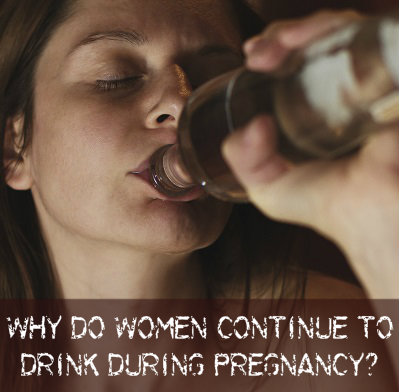 Instead of chastising and condemning pregnant women who drink, we should be devising ways to help them abstain from alcohol during gestation. For hard core alcoholics, it is entirely possible that the only way to stop them from drinking for close to a year would be to physically restrain them. Barring that, however, there are things that we can do to try to reduce the incidence of drinking while pregnant.
Instead of chastising and condemning pregnant women who drink, we should be devising ways to help them abstain from alcohol during gestation. For hard core alcoholics, it is entirely possible that the only way to stop them from drinking for close to a year would be to physically restrain them. Barring that, however, there are things that we can do to try to reduce the incidence of drinking while pregnant.
We, as a society, must be more proactive in teaching people about the risk of fetal alcohol syndrome, a complication that can happen if a mother drinks while pregnant. People born with fetal alcohol syndrome will likely have abnormal faces, growth issues, and problems in the central nervous system. These issues will not improve over time and the neurological impairments can lead to learning disabilities and behavioral issues, like attention deficit disorder. Fetal alcohol syndrome affects up to 3 million people in the US alone.
The problem with teaching about the dangers of fetal alcohol syndrome is that evidence is murky when it comes to determining how much alcohol can safely be consumed before a fetus is put at risk. It used to be, at least prior to the 1980‘s, that doctors never restricted women from drinking alcohol during pregnancy. However, at some point the medical establishment changed its tune and soon no amount of alcohol was permitted during pregnancy. Now, conflicting information can be found everywhere.
How Exactly Does Fetal Alcohol Syndrome Happen?
Babies do not inherit fetal alcohol syndrome. Instead, the ingested alcohol actually damages developing neurons and destroys brain cells. The damage can occur at any point in fetal development, even before the mother knows that she is pregnant. Once the cells have been compromised, there is presently no way to undo the damage.
Educate Teens On Abstaining From Alcohol If Having Sex
Without knowing exactly how much alcohol is safe for fetuses, the only safe option for pregnant women is to avoid drinking altogether. Since drug-related birth defects affect not only the child but society in general, more resources need to be expended to help keep pregnant alcoholics sober during gestation and continually remind women of all ages about the dangers of exposing themselves to toxic substances if there is a chance they could become pregnant. Since alcohol and sex many times go hand in hand, it is a responsible and appropriate discussion to have with kids, especially given how prevalent substance abuse is in some sub-teen populations.
Addiction During Pregnancy – All Of Our Concern
In addition to increasing the amount of materials available to women of child-bearing age regarding the dangers of drinking, medical professionals in all venues need to be more vigilant in identifying mothers who are actively drinking or are at risk of developing a drinking problem during pregnancy. Although alcohol rehab programs have begun offering specialized treatment programs for addicted mothers, the number of available beds is woefully inadequate to handle the sheer number of people requiring treatment. Hopefully governments will begin to see addiction during pregnancy as a public health crises and funnel adequate resources into handling the disease. If someone you know is drinking during pregnancy, encourage them to seek help.
29 Oct 2013
What Drives Teens To Try Ecstasy?
Ecstasy is a widespread term used for MDMA or Molly, an illegal amphetamine-like drug that also has some of the properties of hallucinogenic substances. In a study published in October 2013 in the journal Addiction, a multi-institution Australian research team examined some of the main factors that drive involvement in Ecstasy use. These researchers found that the critical factors include one’s social environment, previous history of drug use and level of a mental state called psychological distress.
Effects And Details Of Ecstasy
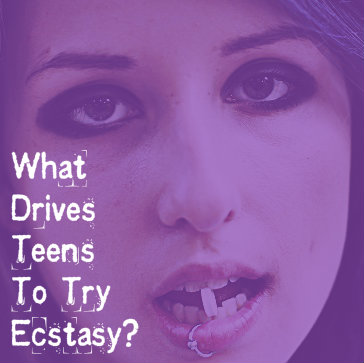 The full chemical name of Ecstasy (MDMA) is methylenedioxymethamphetamine. Outside of very limited situations, manufacturers produce this substance illegally, and distributors also usually sell it outside of legal channels. The stimulant effects of Ecstasy produce alertness and high levels of energy, while the hallucinogen-like effects of the drug produce an impaired ability to track the passing of time and unusual sensitivity to sound and touch. In addition, the drug commonly produces a benevolent mental outlook and an increased sense of social/spiritual connection with others. Ecstasy users typically view these physical and psychological changes as the drug’s desirable effects.
The full chemical name of Ecstasy (MDMA) is methylenedioxymethamphetamine. Outside of very limited situations, manufacturers produce this substance illegally, and distributors also usually sell it outside of legal channels. The stimulant effects of Ecstasy produce alertness and high levels of energy, while the hallucinogen-like effects of the drug produce an impaired ability to track the passing of time and unusual sensitivity to sound and touch. In addition, the drug commonly produces a benevolent mental outlook and an increased sense of social/spiritual connection with others. Ecstasy users typically view these physical and psychological changes as the drug’s desirable effects.
The use of Ecstasy is heavily associated with attendance at parties or dances that feature some form of electronic music; however, use can also take place in a range of other settings. The drug disrupts the body’s ability to regulate its internal temperature. In combination with the high, external body heat levels commonly found at the parties and dances where Ecstasy use occurs, this temperature dysregulation can lead to a dangerous, sometimes lethal condition called hyperthermia, which sets in when the body’s temperature rises above a sustainable level. Additional, major short-term health problems associated with Ecstasy intake include seizures and the development of significant heartbeat instability. Typically, people who take large amounts of the drug in a short span of time have the highest risks for experiencing these problems.
Psychological Distress And Ecstasy
Psychological distress is a term used to describe the presence of a range of emotional states that can undermine a person’s sense of mental well-being. Examples of these emotions include nervousness, hopelessness, restlessness and a “down” mood. By itself, psychological distress does not constitute a diagnosable mental health disorder. However, the underlying effects of a distressed psychological outlook are known contributors to the development of a number of diagnosable mental illnesses, including schizophrenia, bipolar disorder, anxiety disorders and major depression. According to figures compiled by the federal Substance Abuse and Mental Health Services Administration (SAMHSA), young adults experience psychological distress considerably more often than middle-aged adults or elderly adults, and also receive help for their condition less often than adults in these age groups.
Social Environment, Past Drug Use – Factors In Ecstasy Use
In the study published in Addiction, researchers from five Australian institutions used an assessment of 204 young adults between the ages of 19 and 23 to look at the factors that contribute to the start of participation in Ecstasy use. At the beginning of the study, none of these adults had used Ecstasy; however, over 40 percent of them had been offered the drug at some point. Six months later, the researchers identified the participants who had eventually accepted an offer to take Ecstasy and examined the reasons for this change in behavior.
After completing their assessment, the researchers concluded that factors related to an individual’s social environment played the most prominent role in the onset of Ecstasy use among the study’s young adults. Specific factors cited include having social interactions with a lot of people who already use the drug and attending the electronic music/dance events classically associated with Ecstasy use. The presence of the symptoms of psychological distress also played a meaningful role, as did a previous history of using marijuana or other forms of cannabis. However, these factors did not rise to the same level of importance as social environment.
How Study Results Can Help Ecstasy Drug Education
The authors of the study published in Addiction believe that their research can play a role in efforts aimed at curbing the use of Ecstasy and warning users about the drug’s major pitfalls. If successful, such efforts would likely have two components: a large-scale education campaign designed to reach broad segments of the population and a smaller, more targeted campaign designed to reach young adults and other individuals exposed to known risk factors for Ecstasy use.
The long-term risks for teens that abuse substances are increased likelihoods of adult addiction, developing certain cancers or heart disease and engaging in dangerous sexual behaviors that could result in contracting a sexually transmitted disease and/or an unplanned pregnancy. But there are also serious short-term risks, with the most serious being the increased likelihood of getting into a vehicular accident.
In addition, while many teens are advised not to drive a car while under the influence they may not use enough caution when considering the sobriety of another driver.
A recent study highlights the risk teens take when they drive a car or enter the car of a driver that is under the influence. Conducted by researchers at the Mailman School of Public Health at Columbia University, the study examined the risk of drug use and the risk of drug use combined with alcohol use and how such use impacted the risk of a fatal crash.
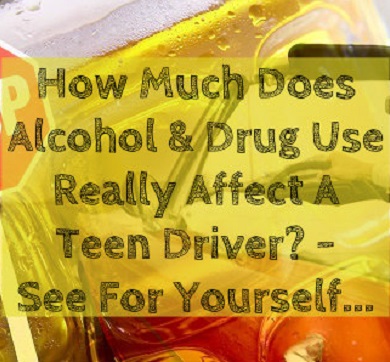
Drastic Increases In Fatal Crashes When Drugs Are Involved
The researchers found that there was a drastically increased risk of experiencing a fatal crash when drugs were involved in an accident, and this was particularly true when the drugs were used in addition to alcohol.
The study’s data was pulled from two national databases commissioned by the National Highway Traffic Safety Administration: the 2007 National Roadside Survey of Alcohol and Drug Use by Drivers and the Fatality Analysis Reporting System (FARS). FARS compiles investigation information for all vehicular crashes that resulted in a fatality within 30 days of the crash occurring on a public road.
This study is unique in its use of the two databases together to compile information about circumstances surrounding events, such as the individuals and vehicles involved.
The study, led by Guohua Li, MD, DrPH, professor of Epidemiology and director of the Center for Injury Epidemiology and Prevention, found that 31.9 percent of all drivers implicated in fatal crashes tested positive for at least one drug. Of those interviewed at roadside, 13.7 percent tested positive for at least one drug. Overall, drivers that test positive were three times more likely to be involved in a fatal car crash, with the highest risk associated with depressants followed by stimulants.
The study also showed that blood alcohol levels were increased in 57 percent of those involved in fatal crashes, while 8.8 percent of the roadside interviews had an elevated blood alcohol level. Approximately 20 percent of the fatal crash drivers tested positive for alcohol consumption and one or more additional drugs. Among the roadside interviews, 2.2 percent tested positive for alcohol and another drug.
Alcohol Increases Fatal Car Crashes By 13 Times!
The risk of involvement in a fatal car crash increased 13 times for those that tested positive for alcohol only, two times for those that were drug-positive and 23 times for drivers that were under the influence of both drugs and alcohol.
The authors of the study note that drugs may be detectable in a driver’s blood test that may not be causing impairment. In addition, the authors say that the study does not account for various levels of tolerance that may be exhibited among individual drivers, making it difficult to measure drug impairment.
Decreased Risks When Parents Talk With Their Teens
The findings highlight the importance of talking with teens about the risks of driving a vehicle while under the influence or entering a vehicle in which the driver has been using.
Parents that explain the risks and dangers can help their child make an informed decision.
When you look at the numbers, it can be discouraging to see how many teenagers continue to experiment with drugs and alcohol as this often leads to addiction. What most teens have difficulty comprehending is how this behavior could affect them for the rest of their lives.
Types Of Drugs Teens Experiment With
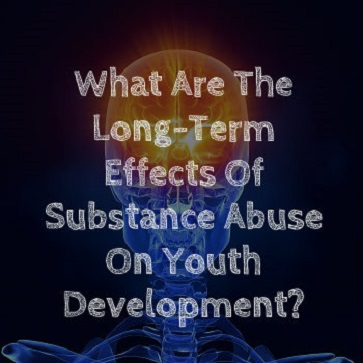 Just over one million American teenagers are addicted to illegal drugs, with another 915,000 addicted to alcohol. Even if they’re not addicted, an alarming number of teens are regularly using, with over half of high school seniors reporting having experimented with drugs and close to 30 percent having tried something other than marijuana, like heroin, cocaine, prescription drugs, inhalants, sedatives and mind-altering hallucinogens. The highest rate (19.9 percent) of illegal drug use occurs between 18 and 20 years, with the next highest rate (16.4 percent) happening between 16 and 17.
Just over one million American teenagers are addicted to illegal drugs, with another 915,000 addicted to alcohol. Even if they’re not addicted, an alarming number of teens are regularly using, with over half of high school seniors reporting having experimented with drugs and close to 30 percent having tried something other than marijuana, like heroin, cocaine, prescription drugs, inhalants, sedatives and mind-altering hallucinogens. The highest rate (19.9 percent) of illegal drug use occurs between 18 and 20 years, with the next highest rate (16.4 percent) happening between 16 and 17.
Alcohol use affects more than 10 million teens, with 5.1 million regularly binge drinking, which is defined as downing more than four or five drinks during a single sitting. Not far behind is inhalant abuse, with 25 percent of all teens 10- to 17-years-old saying they have friends who inhale dangerous fumes from things like paint, computer cleaner or glue.
Teen Drug Use Can Have Negative Effects For Years To Come
Unfortunately, the bad choices made in youth can haunt for years to come. The brain undergoes vital development during adolescence. Not since infancy has their brain been changing and forming with such rapidity.
Drug use can disturb the proper development of the prefrontal cortex in the brain. This area of the brain is responsible for important functions like organization, risk assessment, impulse control, consequence prediction and planning. But the limbic system, corpus callosum, hippocampus and cerebellum are all still forming and vulnerable to the changes wrought by drugs. Functions like emotional control, goal-setting and memory/recall are all still developing, and drug use could cause permanent problems in these areas.
Studies have repeatedly shown that heavy marijuana use damages key brain functions for years, with some researchers believing the changes are permanent. Processes like critical thinking, planning and complex attention are all shown to be diminished by heavy marijuana use. Girls seem to experience longer-lasting ill-effects, but both females and males show problems with myelin sheath formation, which affects brain signaling.
MDMA, which also goes by Molly and ecstasy, is associated with sensations of euphoria and social bonding, which is why it’s popular with young people attending large group gatherings such as concerts and dance clubs. Ironically, lowered serotonin levels as long as seven years have been observed in laboratory animals after they’ve been given MDMA, with serotonin closely associated with emotional happiness.
Alcohol causes harm to adolescent brains as well, especially binge drinking. Heavy drinking in teens has been shown to lower their ability to problem solve and understand spatial relationships, as well as memory and vocabulary impairment. And just like drugs, alcohol affects the limbic system, meaning emotional well-being is disrupted. In fact, there appears to be a connection between drinking and behavioral problems due to a lack of emotional control — researchers just aren’t sure which problem came first.
Using drugs and alcohol during adolescence can have serious and long-lasting results, with neurological development issues, impaired social development and addiction. And all of these problems can easily follow teens into adulthood.
Read More About The Effects Of Teen Substance Abuse On Families


